





 The
wood in the entry is constructed of rare white Port Orford Cedar wainscoting
with a cantilevered staircase and a Japanese style wood railing. It is the only
white cedar in the world and used in Japan to build temples. A design motif
utilized by the Greenes throughout the house includes the "cloud lift"
which is featured on furniture, doors, doorframes, window frames, drawer pulls
and brickwork. A scroll is another element, which is featured on metal work and
built-ins and light fixtures. Numerous butterfly joinery details are found
throughout the house, and Japanese "tsuba" sword sheath is the shape of the
dining room furniture.
The
wood in the entry is constructed of rare white Port Orford Cedar wainscoting
with a cantilevered staircase and a Japanese style wood railing. It is the only
white cedar in the world and used in Japan to build temples. A design motif
utilized by the Greenes throughout the house includes the "cloud lift"
which is featured on furniture, doors, doorframes, window frames, drawer pulls
and brickwork. A scroll is another element, which is featured on metal work and
built-ins and light fixtures. Numerous butterfly joinery details are found
throughout the house, and Japanese "tsuba" sword sheath is the shape of the
dining room furniture.
The 1992, Whittier Narrows earthquake damaged the house substantially. The
original plaster was attached to the wood lath. It cracked and then expanded
with moisture and began to peel off, leaving gaping holes in the walls and
ceilings. Most of the lath and plaster was replaced during the long
restoration process that began in 1998, and 90% of all windows and screens
were discarded and reconstructed on site. Over the main staircase, chains
from the second floor atrium entrance suspend an original hexagonal mahogany
and stained glass lantern. This chandelier was dangling on one chain after
the earthquake and was removed for safekeeping. It was finally restored and
replaced in 2004.
Other notable areas in the house include a library with a fireplace and a
built-in inglenook. The living room overlooks the expanse of the Arroyo
Seco and Colorado Bridge and features a large fireplace, cabinets and
decorative framing constructed of rare Honduras mahogany. The light
fixtures, andirons and , drop-front desk desk and sofa are replicas of the
original Greene and Greene circa 1906 furniture. The living room leads into
a solarium with intricate mahogany carved panels depicting the sunrise,
moon, stars and sunset and seagulls oriented in the corresponding cardinal
directions of the room. Architect Charles Greene carved these panels during
his "celestial period" while living in Carmel, California. A new large porch
with French doors allow guests to step outside to the new south fountain
depicting a life sized, hand carved ceramic tile tree.
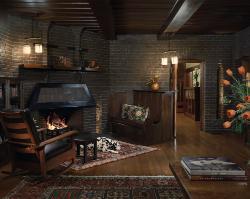 Library Library | 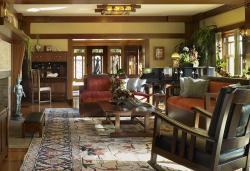 Living Room Living Room |
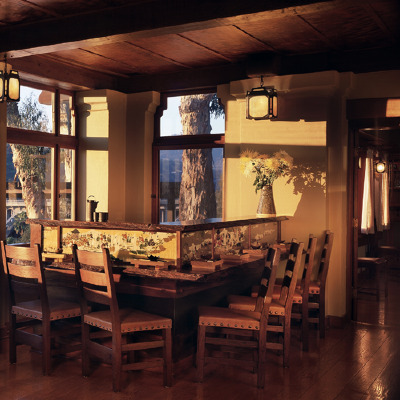 A
new sushi bar constructed of live-edge
redwood features a backlit "chiyogami" depicting the relocation of the
Japanese capital of Edo to Tokyo. Original Gustav Stickley chairs allow guests
to view the sunset while enjoying sushi.
A
new sushi bar constructed of live-edge
redwood features a backlit "chiyogami" depicting the relocation of the
Japanese capital of Edo to Tokyo. Original Gustav Stickley chairs allow guests
to view the sunset while enjoying sushi.
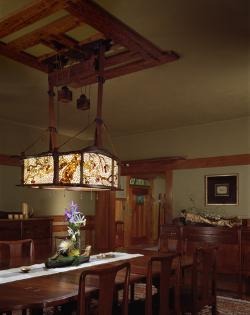 A
replica of the dining room with its original furnishings can be seen at the
Huntington Gardens and Library. Mahogany side boards with ribboned inlay
surround a magnificent chandelier with over 3000 pieces of curved glass
depicting a cherry tree. Organic shapes such as the pods and vines characterize
the Greene's designs in glass. Emil Lange, who also worked for Tiffany produced
all of the original art glass in the house. The dining room chandelier has an
elaborate system of weights and leather straps. The rug is an antique Persian
signed silk Tabriz signed by Ghasempour with a central medallion.
A
replica of the dining room with its original furnishings can be seen at the
Huntington Gardens and Library. Mahogany side boards with ribboned inlay
surround a magnificent chandelier with over 3000 pieces of curved glass
depicting a cherry tree. Organic shapes such as the pods and vines characterize
the Greene's designs in glass. Emil Lange, who also worked for Tiffany produced
all of the original art glass in the house. The dining room chandelier has an
elaborate system of weights and leather straps. The rug is an antique Persian
signed silk Tabriz signed by Ghasempour with a central medallion.
The Robinsons entertained dignitaries regularly and needed storage
for a variety of china. A few years after the completion of the house in
1906, the butler's pantry was expanded. The back porch made it possible to
receive ice directly into the 1910 icebox which still exists today. Large
vertical cabinets near the dining room door were designed to house the
extra leaves of the dining table.
Oversized drawers minimized
creases in the table linens. The original wood warming drawer is restored and
functional and a matching wood cabinet was built near the warming drawer to conceal
a microwave oven.
A replica of a unique transitional fixture which utilized both gas
and electricity can be also be found in the butler's pantry. Two
additional restored and original transitional fixtures in the library and
master bathroom are an anachronistic reminder of how electricity was
still unreliable in the early 1900's.
The original kitchen had a separate mudroom. During the
restoration, a 16"
brick wall that separated mudroom from the kitchen was removed to
create one
large room spanned by a wood covered I-beam. The only original remnants of
the kitchen are the windows and the hood over the stove. The
original
cabinets are now in the garden shed near the beer tap palm garden.
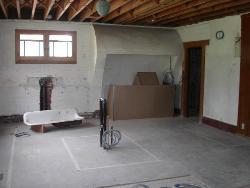 Kitchen Before Kitchen Before | 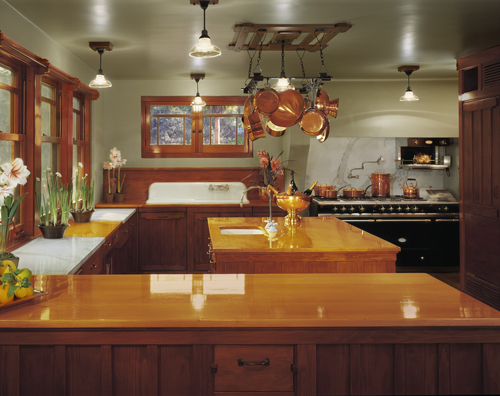 Kitchen Now Kitchen Now |
Phaedra designed the new kitchen including a large central pot
hanger that
incorporates a wood ceiling plate inspired by the original
entrance and
dining room chandelier.
The pendant lights were refurbished with new
halofane glass shades. The sink is a vintage porcelain drain board
with its
original finish. New oak wood floors were also installed in the
kitchen. The
lower baking counters and the wall behind the new French Lacanche
stove are
made of Calcutta Gold marble slab. All other counters are
constructed of
sugar pine, a material historically used in Craftsman-style
kitchen
countertops. Modern appliances are concealed behind wood cabinets
(wine
refrigerator, double refrigerators, trash compactor and dish
washer). Spice
racks pull out between the refrigerators and a
"push-me-pull-you" drawer
allows flatware and napkins to be reached from both sides of the
peninsula
near the breakfast nook. The faucet handles on the island are also
vintage.
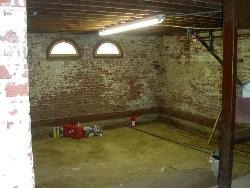 For
most of the time during the restoration of the house, the basement was the wood
shop. All of the windows and screens were built here as well as the doorframes
and all other millwork and carpentry.The theater was originally used as a
furnace room and was sloped to accommodate the shoveling of coal to stoke the
fires. The brick walls were originally plastered over, and none of the
intricate brickwork which now conceals the HVAC existed. Workers tediously
chiseled out space between the brick for months, removing extraneous grout to
reveal the three-dimensional beauty of the brick.
For
most of the time during the restoration of the house, the basement was the wood
shop. All of the windows and screens were built here as well as the doorframes
and all other millwork and carpentry.The theater was originally used as a
furnace room and was sloped to accommodate the shoveling of coal to stoke the
fires. The brick walls were originally plastered over, and none of the
intricate brickwork which now conceals the HVAC existed. Workers tediously
chiseled out space between the brick for months, removing extraneous grout to
reveal the three-dimensional beauty of the brick.
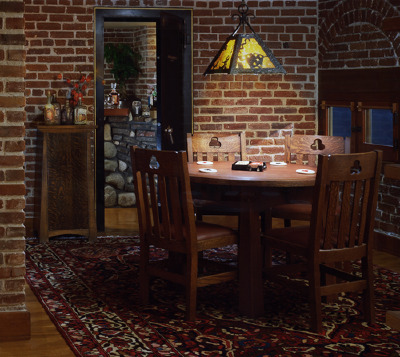 The
poker room houses an antique vice cabinet and the door leading into the
prohibition bar is a metal safe door used to conceal liquor during the
prohibition. Klinker bricks were used to make the new bar, which has glowing
backlit owl andirons.
The
poker room houses an antique vice cabinet and the door leading into the
prohibition bar is a metal safe door used to conceal liquor during the
prohibition. Klinker bricks were used to make the new bar, which has glowing
backlit owl andirons.
 Prohibition Bar
Prohibition Bar
The
new billiard room was designed to allow guests to play while watching the large
screen that descends on the theater stage.
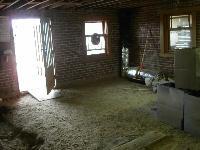 Billiard Room Before Billiard Room Before | 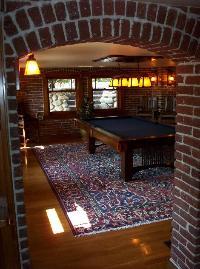 Billiard Room Now Billiard Room Now |
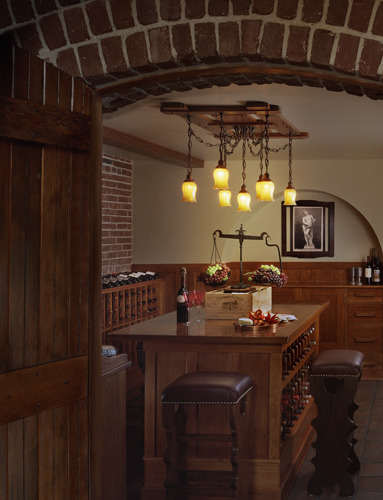 The
wine cellar was originally used to store coal. The floor in the wine cellar was
lowered 18" to allow more head room. Phaedra designed the wine cellar with
new exposed beams and added a curved niche area new wainscoting, and hand made
tile flooring was installed. The chandelier is new and was inspired by the dining room chandelier at the Duncan Irwin house, another
Greene and Greene home in Pasadena.
The
wine cellar was originally used to store coal. The floor in the wine cellar was
lowered 18" to allow more head room. Phaedra designed the wine cellar with
new exposed beams and added a curved niche area new wainscoting, and hand made
tile flooring was installed. The chandelier is new and was inspired by the dining room chandelier at the Duncan Irwin house, another
Greene and Greene home in Pasadena.
 The
new sauna in the basement opens up to an outdoor shower, the infinity edge pool, outdoor kitchen and 4-acre garden.
The
new sauna in the basement opens up to an outdoor shower, the infinity edge pool, outdoor kitchen and 4-acre garden.